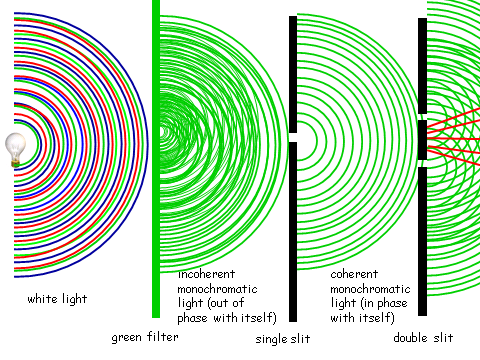
The diagram below shows the reflected wavefronts and the reflected ray. Upon reaching the barrier placed within the water, these waves bounce off the water and head in a different direction. The blue arrow is called a ray and is drawn perpendicular to the wavefronts. The direction that these wavefronts (straight-line crests) are traveling through the water is represented by the blue arrow.

Refraction and diffraction series#
The diagram at the right depicts a series of straight waves approaching a long barrier extending at an angle across the tank of water. These waves will travel through the water until they encounter an obstacle - such as the wall of the tank or an object placed within the water. As viewed on the sheet of paper below the tank, the crests are the dark lines stretching across the paper and the troughs are the bright lines. These straight waves have alternating crests and troughs. If a linear object attached to an oscillator bobs back and forth within the water, it becomes a source of straight waves. Ripple tank demonstrations are commonly done in a Physics class in order to discuss the principles underlying the reflection, refraction, and diffraction of waves. As the waves encounter obstacles in their path, their behavior can be observed by watching the movement of the dark and bright spots on the sheet of paper. As the water waves move through the ripple tank, the dark and bright spots move as well.

So the bright spots represent wave troughs and the dark spots represent wave crests. A crest of water will absorb more light than a trough. A portion of light is absorbed by the water as it passes through the tank. A light typically shines upon the water from above and illuminates a white sheet of paper placed directly below the tank. A ripple tank is a large glass-bottomed tank of water that is used to study the behavior of water waves.

The study of waves in two dimensions is often done using a ripple tank. But what if the wave is traveling in a two-dimensional medium such as a water wave traveling through ocean water? Or what if the wave is traveling in a three-dimensional medium such as a sound wave or a light wave traveling through air? What types of behaviors can be expected of such two- and three-dimensional waves? Specifically, there will be some reflection off the boundary and some transmission into the new medium. Rather, a wave will undergo certain behaviors when it encounters the end of the medium. The wave doesn't just stop when it reaches the end of the medium. Previously in Lesson 3, the behavior of waves traveling along a rope from a more dense medium to a less dense medium (and vice versa) was discussed.


 0 kommentar(er)
0 kommentar(er)
